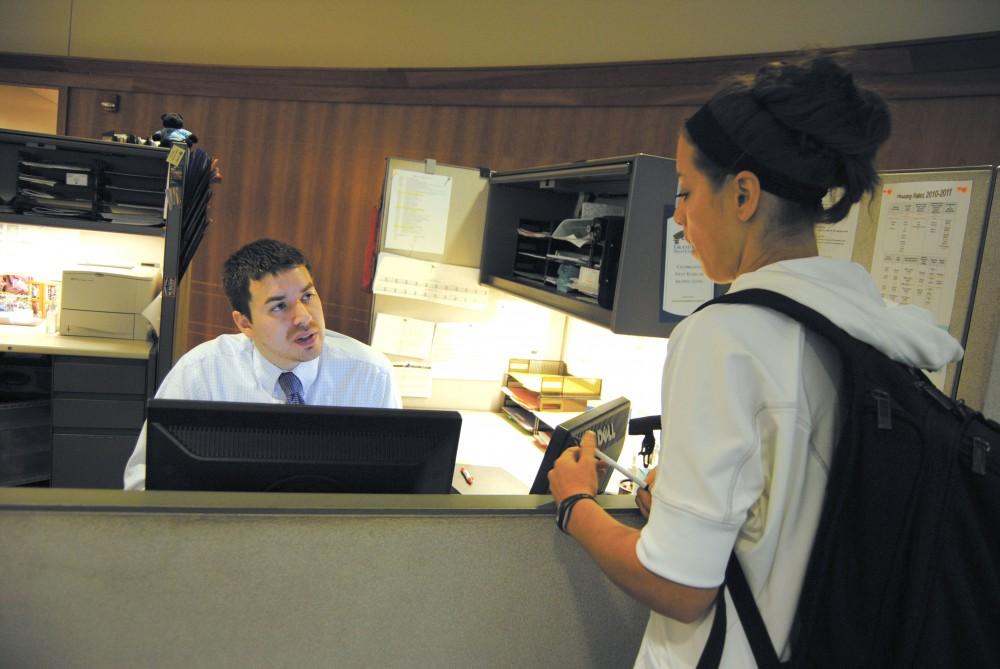Student debt on the rise

GVL/ Rane Martin Junior Monica Yothers receives in-depth advice from a Financial Aid advisor.
Sep 1, 2011
Garcia, an English and secondary education major, currently carries $30,000 in student loan debt with at least two years left before he graduates. Each year, he takes out the maximum amount in Stafford loans while his parents help him pay for the remainder.
“I am poor,” Garcia said of the impact of his student loans. “I’ve never been rolling in money or anything, but now I have negative money. … I’m pretty bad.”
Even paying rent poses a monthly challenge for Garcia, 20, who sometimes gets assistance from his family when funds run low.
Garcia is just one of many students who face significant financial barriers when paying for school. The cost of college has skyrocketed across the state in recent years, leaving today’s college students struggling to make their educational ends meet.
According to data from the Project on Student Debt, Grand Valley State University graduates in 2009 left school with an average debt of more than $24,000, slightly below the state-wide average of $25,458. That year, 70 percent of GVSU graduates carried some student loan debt with them into their professional lives.
While GVSU increased its tuition by 6.9 percent for the 2011-2012 academic year – the university’s largest tuition hike in years – college costs have been climbing at a rate higher than inflation for decades.
However, GVSU has remained one of the most affordable public universities in the state. In a nine-year period from 1998 to 2007, GVSU tuition increased by 84 percent, the second-lowest increase in the state during that period.
Garcia said he worries about how the cost of college will impact him after graduation.
“I’m going to be a teacher, and that means I am not going to make much money,” he said. “I will be struggling financially for a few years.”
The university has increased its scholarship awards in an effort to help combat rising costs. In 2010, GVSU offered 275 scholarships, up from 50 a decade earlier.
“I think students are becoming very creative in how to pay for college,” said Michelle Rhodes, director of the Office of Financial Aid at GVSU. “I think they are getting better at planning ahead and making sure they don’t overspend. I always encourage students to start a budget so they can plan accordingly.”
According to the Project on Student Debt, the average national student debt increased 20 percent between 2004 and 2008. Only 24 percent of GVSU students who demonstrated financial need in 2010 had all of their financial needs met, leaving many to depend on help from their parents, wages or private loans to fill the gaps.
Despite that, Rhodes said she has seen the number of private loans students take out decrease over the past three years, a finding that bucks the national trend.
Private loans often have higher interest rates than Stafford loans issued by the federal government, and many do not offer a deferment period to students still in school.
“I think [students] are starting to ask better questions to understand their costs,” Rhodes said. “I think making sure we communicate to our students all along about planning for their future, repayment of loans, etc. is important. I think it’s critical that each student understands and makes sure they are only taking the loans they need and not just everything that’s offered to them.”
In spite of the costs, Garcia believes that college is worth the financial burden.
“Without college I could not do what I really want which is teaching high school English,” Garcia said. “I’ve grown so much as a person that it can’t be given too much of a cost. The economy sucks and my economy sucks even more but at least I’ll be content with my life, money aside.”
For information about student loans, scholarships and other financial questions, visit the Financial Aid Office online at www.gvsu.edu/financialaid.





















